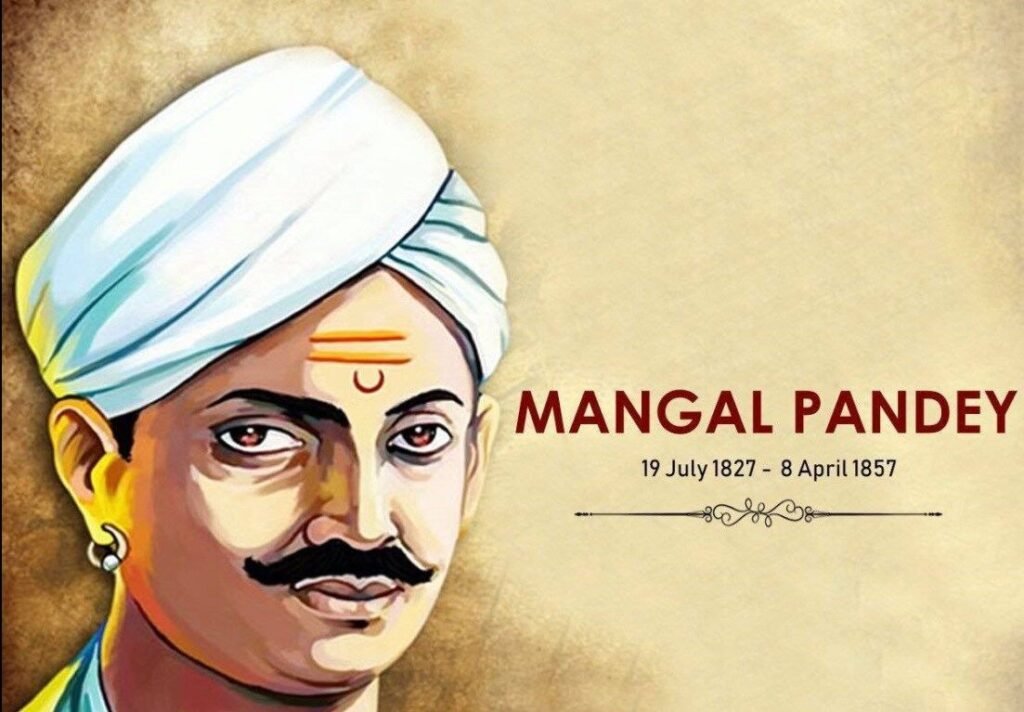Introduction:
India’s struggle for independence witnessed numerous valiant individuals who dared to defy the shackles of colonial rule. And Mangal Pandey stands tall among them. Born on July 19, 1827, in the quaint village of Nagwa in the Ballia district of Uttar Pradesh, Mangal Pandey’s life journey reflects the spirit of resistance against British oppression.
Entry into Service:
10 lines on mangal pandey in english began his tryst with destiny when he joined the Bengal Army in 1849. A sepoy. Or soldier. In the British East India Company’s Bengal Native Infantry regiment. He soon emerged as a symbol of resistance against the British rule. His significance in India’s freedom struggle is deeply rooted in the events that transpired in 1857. Which later became known as the Indian Rebellion of 1857 or the First War of Independence.
Religious Conflict:
The incidents leading to Mangal Pandey’s rebellion were not isolated but were embedded in the broader context of discontentment among Indian sepoys. The year 1857 was fraught with tension, fueled by a variety of factors, including the introduction of new rifle cartridges greased with animal fat. This seemingly innocuous change had severe repercussions, especially for the Hindu and Muslim soldiers, as it offended their religious sentiments.
Barrackpore Incident:
Mangal Pandey’s act of defiance on March 29, 1857, in Barrackpore, present-day West Bengal, marked the beginning of a larger uprising. The cartridges. Rumored to be coated with pig and cow fat, were to be bitten off before loading into the Enfield rifles. Pandey, a devout individual, refused to accept these cartridges, and his refusal cascaded into a rebellion against the British officers.
Capture and Sentencing:
The Rebellion of 1857, often referred to as the Sepoy Mutiny, was characterized by a series of revolts and clashes against the British East India Company. Mangal Pandey’s role was pivotal in escalating the discontent among the sepoys into a full-fledged rebellion that echoed across the northern regions of India. His actions inspired other Indian soldiers to join the fight for independence.
Pandey’s act of resistance took a dramatic turn when he attacked British officers, aiming to protect his religious beliefs and defy the oppressive policies imposed by the British rulers. On March 29, 1857, he targeted Sergeant-Major James Hewson and Adjutant Lieutenant Henry Baugh. The confrontation resulted in the first gunfire on an Englishman during the revolt of 1857.
Execution:
The British responded swiftly to suppress the uprising, and Mangal Pandey was arrested. His subsequent trial, which took place after a week, ended with his death sentence. Despite his capture, Pandey’s actions had already sown the seeds of rebellion. He was hanged on April 8, 1857, in Barrackpore, just 10 days before the originally scheduled date.
Mangal Pandey’s sacrifice and bravery left an indelible mark on India’s fight for independence. His actions, though seemingly isolated, were symbolic of the broader discontentment prevailing among Indians against the East India Company’s oppressive rule. The events surrounding Mangal Pandey’s rebellion eventually contributed to the larger uprising that challenged British colonial rule in India.
The background leading to Mangal Pandey’s mutiny included several factors that fueled the general dissatisfaction among Indian sepoys and the public. The Doctrine of Lapse, introduced by Governor-General Dalhousie, resulted in the annexation of Indian princely states. This policy, coupled with religious and cultural insensitivity shown by the British, intensified the feeling of frustration and anger.
Symbol of Resistance:
Mangal Pandey’s resistance against the use of the controversial cartridges became a focal point for the sepoys to express their collective discontent. The use of grease made from pig and cow fat in the cartridges offended both Hindu and Muslim soldiers, leading to suspicions of forced religious conversions. The distribution of Bibles in Indian languages among the soldiers further fueled apprehensions.
Legacy:
The mutiny led by Mangal Pandey, though quelled by the British, marked the beginning of a more extensive and organized revolt. The repercussions of the rebellion spread across northern India, with Meerut becoming another epicenter of the uprising on May 10, 1857. The events that followed shaped the trajectory of India’s struggle for independence.
Mangal Pandey’s life reflected the intersection of personal beliefs, religious sentiments, and the broader socio-political landscape of colonial India. Born into a Brahmin family in Nagwa, he was compelled to join the British army for livelihood. Underscoring the economic compulsions faced by many Indians during that era. His ambitions clashed with his religious beliefs, and the introduction of the controversial cartridges provided the spark for his rebellion.
The trial and subsequent execution of Mangal Pandey did not diminish the impact of his actions. Instead, it added fuel to the fire of resistance against British rule. The disbandment of the entire 34th Regiment of Bengal Native Infantry reflected the gravity of the situation. The soldiers, despite being disbanded, had successfully transmitted the spirit of rebellion.
National Hero:
Mangal Pandey’s legacy endured beyond his execution. His pivotal role in the revolt of 1857. Often referred to as the First War of Independence, earned him a place in the annals of Indian history. The courage displayed by Pandey became a source of inspiration for future generations of freedom fighters.
The significance of Mangal Pandey’s contribution to India’s struggle for independence is further highlighted by the various artistic and cinematic representations of his life. The movie “Mangal Pandey: The Rising” delves into the narrative of this unsung hero. Capturing the essence of his defiance and the impact it had on the broader canvas of the freedom movement.
Also Read: “Jhansi Ki Rani: An Epic Poem on Rani Lakshmi Bai in English”
In conclusion:
10 lines on mangal pandey in english, though often overshadowed by other prominent figures in India’s struggle for independence. Played a crucial role in shaping the course of history. His rebellion in 1857. Fueled by a confluence of religious sentiments. Economic compulsions. And colonial oppression. Became a catalyst for a more extensive uprising against British rule. Mangal Pandey’s sacrifice and indomitable spirit symbolize the resilience and determination of countless unsung heroes who fought for the freedom of their homeland.
Keywords: 10 lines on mangal pandey in english. Sepoy Mutiny. Indian Rebellion of 1857. First War of Independence. Barrackpore. Bengal Native Infantry. British East India Company. Doctrine of Lapse. First gunfire on Englishman. The Rising (movie). Unsung hero. Freedom struggle. British colonial rule. India’s struggle for independence. Revolt of 1857. Mangal Pandey’s legacy. Symbol of resistance. Economic compulsions. Religious sentiments, Artistic representations, Cinematic portrayal, Sacrifice, Determination, Resilience, Unsung heroes, Homeland, Indomitable spirit.







